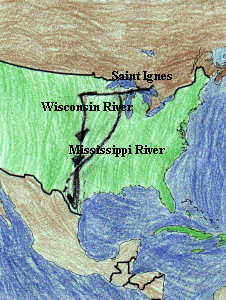
During the summer of 1673, Father Jacques Marquette became the first Frenchman to explore the Mississippi River.
Marquette’s opportunity to explore this river came after he opened a mission on Mackinac Island. On May 17, 1673, Marquette and Louis Jolliet, a Canadian-born fur trapper and explorer, along with five other men described as “simple, hardy, and unwashed,” set out in two canoes from St. Ignace.
They traveled along the northern shore of Lake Michigan and paddled about thirty miles a day.
In two weeks, they reached present-day Menominee, Michigan. The local Indians warned the Frenchmen if they went farther they would meet Indians “who never show mercy to strangers but break heads without any cause.” The Indians also told Marquette and Jolliet that the great river “was full of horrible monsters, which devoured men and canoes one bite.”
Despite these forewarnings, the Frenchmen pressed on. After crossing present-day Wisconsin, they paddled into the Mississippi River on June 17.
Marquette and Jolliet followed the river, but near present-day Arkansas, they turned around after realizing the river flowed south, not west.
After the Marquette-Jolliet Mississippi expedition, the French, relying on Marquette’s research and following their usual practice of naming rivers after the tribes that lived along them, began calling the Des Moines River “Riviere de Moingoana.”
Father Jacques Marquette, French-born missionary of the Jesuit order, and Louis Jolliet, Canadian explorer and mapmaker, were the first Europeans to view the land on which the City of Chicago was to stand.
Iowa has a lot of towns, rivers and even some companies with Native American names. For example, Winnebago Industries, Inc., is headquartered in Forest City, Iowa.
